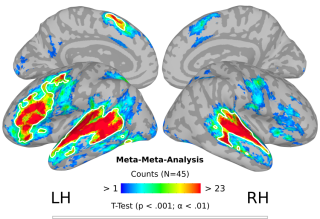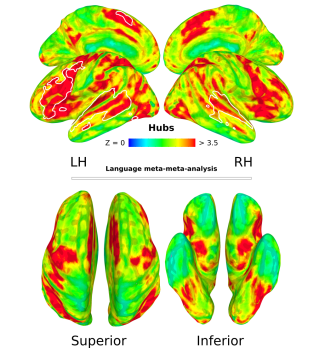Bangjie Wang, Sarah Aliko, and Jeremy I Skipper
Abstract
Introduction
Neo-localizationist (e.g., ‘dual-stream’) models of the neurobiology of language suggest that a small number of anatomically fixed brain regions are responsible for language functioning. This observation derives from centuries of analyzing brain lesions causing aphasia and is supported by decades of neuroimaging studies. The latter rely on thresholded measures of central tendency applied to activity patterns resulting from heterogeneous stimuli and participants. We hypothesize that these methods obscure the whole brain distribution of regions supporting language processing. Specifically, we suggest that ‘language regions’ are input regions and connectivity hubs. The latter primarily coordinate other peripheral regions whose activity is highly variable, making them likely to be spatially averaged out when thresholding is applied.
Methods
We conducted three analyses to provide support for this model. First, we did a ‘meta-meta-analysis’ to demonstrate that ‘language’ activates the same regions in neuroimaging studies. This consisted of 85 individual meta-analyses of language representations (e.g., phonemes, words, sentences) and associated processes (e.g., speech, semantics, syntax), derived from the brainmap.org (N=28) and neurosynth.org (N=57) databases. Each meta-analysis was thresholded at p < .01 FDR corrected for multiple comparisons using a minimum cluster size of 50 voxels and combined by count. Second, we developed a meta-analytic network connectivity hub metric. Specifically, degree centrality was calculated via 165,953 voxel-wise co-activation meta-analyses across 14,371 studies, thresholded at p < .01 FDR corrected and combined by count. The resulting map was converted to z-scores to identify hubs, using 3.5 standard deviations from the mean as a cutoff (p < 0.0005). Third, the neuroquery.org database was used to conduct meta-analyses of ‘verbs’ (N=662) and ‘nouns’ (N=889) to demonstrate that language is distributed across the whole brain when specific linguistic categories are not indiscriminately averaged over.
 Results
Results

The 45 meta-analyses that survived thresholding all roughly activated the same regions regardless of language representation or associated linguistic process, including the bilateral superior temporal gyrus (STG), posterior middle temporal gyrus (pMTG), and posterior inferior frontal gyrus (pIFG; Figure 1).

 Close
Close

